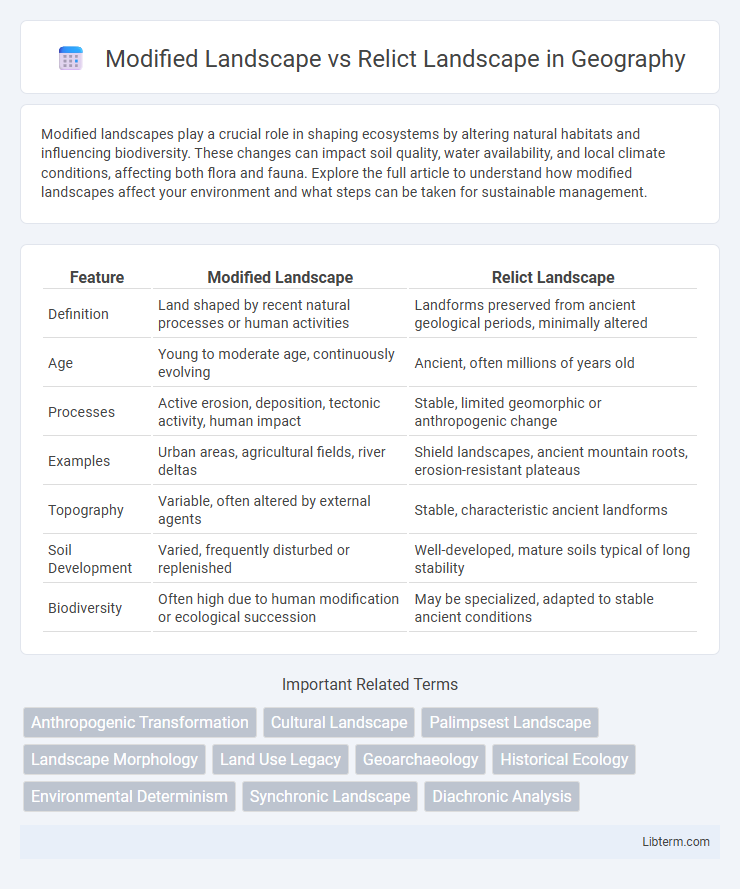Modified landscapes play a crucial role in shaping ecosystems by altering natural habitats and influencing biodiversity. These changes can impact soil quality, water availability, and local climate conditions, affecting both flora and fauna. Explore the full article to understand how modified landscapes affect your environment and what steps can be taken for sustainable management.
Table of Comparison
| Feature | Modified Landscape | Relict Landscape |
|---|---|---|
| Definition | Land shaped by recent natural processes or human activities | Landforms preserved from ancient geological periods, minimally altered |
| Age | Young to moderate age, continuously evolving | Ancient, often millions of years old |
| Processes | Active erosion, deposition, tectonic activity, human impact | Stable, limited geomorphic or anthropogenic change |
| Examples | Urban areas, agricultural fields, river deltas | Shield landscapes, ancient mountain roots, erosion-resistant plateaus |
| Topography | Variable, often altered by external agents | Stable, characteristic ancient landforms |
| Soil Development | Varied, frequently disturbed or replenished | Well-developed, mature soils typical of long stability |
| Biodiversity | Often high due to human modification or ecological succession | May be specialized, adapted to stable ancient conditions |
Introduction to Modified and Relict Landscapes
Modified landscapes are areas where human activities have significantly altered natural landforms, ecosystems, or vegetation through urban development, agriculture, or industrialization. Relict landscapes, in contrast, are relatively unchanged regions that preserve ancient geomorphic features and ecosystems, providing valuable insights into historical environmental conditions. Understanding the distinction between these landscapes aids in studying anthropogenic impacts and conserving natural heritage.
Defining Modified Landscapes
Modified landscapes are areas where human activities such as urban development, agriculture, or mining have altered natural landforms and ecosystems, resulting in significant changes to soil composition, vegetation cover, and hydrology. These landscapes contrast with relict landscapes, which remain largely unchanged since their formation, preserving original geological and ecological characteristics. Understanding modified landscapes is crucial for land management and ecological restoration efforts aimed at mitigating human impact on the environment.
Understanding Relict Landscapes
Relict landscapes are ancient landforms preserved from prior geological eras, representing stable environments that have undergone minimal alteration by recent processes. These landscapes provide valuable insights into past climatic conditions, tectonic activities, and erosional patterns, serving as natural archives for studying Earth's history. In contrast to modified landscapes, which are shaped by ongoing natural or anthropogenic forces, relict landscapes remain relatively unchanged, making them crucial for reconstructing the evolution of Earth's surface.
Key Characteristics of Modified Landscapes
Modified landscapes exhibit significant human influence, characterized by altered landforms, vegetation, and hydrology due to agriculture, urbanization, or infrastructure development. Key characteristics include reduced biodiversity, soil compaction, and changes in natural water flow patterns, leading to ecosystem fragmentation and altered nutrient cycles. These landscapes often show evidence of continuous human activity, contrasting with relict landscapes that retain original geomorphic features and minimal anthropogenic disturbance.
Features of Relict Landscapes
Relict landscapes exhibit ancient geomorphological features preserved from previous climatic or geological conditions, often characterized by steep slopes, eroded surfaces, and resistant rock formations. These landscapes show minimal signs of recent tectonic or erosional activity, maintaining features such as old river terraces, weathered bedrock, and paleosols. Unlike modified landscapes altered by human activity or recent natural processes, relict landscapes provide critical insight into the Earth's geological history and long-term environmental stability.
Human Impact on Modified Landscapes
Modified landscapes exhibit significant alterations due to human activities such as urban development, agriculture, and industrialization, which disrupt natural ecosystems and biodiversity. In contrast, relict landscapes remain relatively unchanged, preserving original geological and ecological features, often serving as valuable benchmarks for environmental studies. Human impact on modified landscapes leads to soil degradation, habitat fragmentation, and altered hydrological cycles, intensifying challenges for conservation and sustainable land management.
Preservation and Value of Relict Landscapes
Relict landscapes preserve ancient landforms and ecosystems, offering invaluable insights into past climatic and geological conditions that guide contemporary environmental management. Unlike modified landscapes altered by human activity, relict landscapes retain natural features, making them critical for biodiversity conservation and cultural heritage preservation. Their unaltered state provides essential benchmarks for assessing environmental change and supports scientific research and sustainable land-use planning.
Case Studies: Examples of Each Landscape Type
Modified landscapes, such as the terraced rice fields of the Philippine Cordilleras, showcase human intervention altering natural landforms for agriculture and sustainability. Relict landscapes like Scotland's Cairngorms National Park preserve ancient geological features and ecosystems largely unchanged by modern development. These case studies highlight the contrast between landscapes shaped by extensive human activity and those maintaining historical natural conditions.
Environmental Implications and Challenges
Modified landscapes, shaped by human activities such as urbanization, agriculture, and deforestation, often face challenges including habitat fragmentation, soil degradation, and altered hydrological cycles that negatively impact biodiversity and ecosystem services. Relict landscapes, preserved or minimally disturbed natural areas, serve as essential refuges for native flora and fauna, maintaining ecological stability and genetic diversity but are increasingly threatened by encroaching development and climate change. Managing environmental implications in both landscapes requires balancing conservation efforts with sustainable land use to mitigate biodiversity loss, soil erosion, and water quality decline.
Comparing Modified and Relict Landscapes
Modified landscapes show significant human intervention, such as urban development, agriculture, and deforestation, altering natural processes and ecological systems. Relict landscapes retain their original natural features and processes, minimally impacted by human activity, preserving ecological stability and biodiversity. Comparing these landscapes highlights the degree of anthropogenic influence, with modified landscapes exhibiting reduced ecological resilience and altered landforms compared to the more pristine and stable conditions of relict landscapes.
Modified Landscape Infographic

 libterm.com
libterm.com